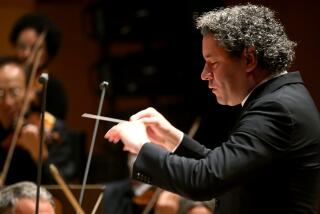A Tale of Two Long-Neglected Symphonies
- Share via
The Great Patriotic War, a.k.a. World War II, enlisted many of the best composers of the day in the manufacture of jingoistic musical ammunition for the home front. Not least of them was Corp. Samuel Barber of the U.S. Army. But his Second Symphony--dedicated to the Army Air Force--did not fare well, ultimately leading him to tear it up.
A new recording, however, is about to return the work to the public ear. Friday is the 45th anniversary of the composition’s premiere, and the release date for Andrew Schenck’s interpretation recorded with the New Zealand Symphony.
Drafted in 1943, Barber produced a “Commando March” for band and a three-movement symphony. Though he claimed to have no specific program for his symphony, Barber used a newly developed tone generator in the second movement to simulate radio beams used in guiding night flying and later revised the movement as a separate tone poem, “Night Flight.”
The symphony was performed by Koussevitsky and the Boston Symphony in 1944 concerts--to positive reviews--was sent to England and the Soviet Union, and distributed on Victory-Discs. The composer, however, was not satisfied. In 1948, he demilitarized the piece, purging the tone generator and other instrumental indulgences in a revised version premiered by Eugene Ormandy and the Philadelphia Orchestra. The further-amended “Night Flight” portion was first given by George Szell and the Cleveland Orchestra in 1964.
Despite these high-powered orchestral champions, the Second Symphony languished. After a conversation with his publisher in 1971, Barber abruptly withdrew the manuscript, destroyed it and consigned all performance materials to a similar fate. When the composer died 10 years later, that was thought to be the end of the Second Symphony as well, although copies of the published score (long out of print) were obtainable.
Enter American conductor Andrew Schenck, music director of the Nassau Symphony. He has planned a multi-album survey of Barber’s music; the first installment, with the London Symphony on ASV, was released in 1986. Discussions with Barber’s publisher, G. Schirmer, revealed that a European distributor failed to carry out the search-and-destroy mission on the orchestral parts of the Second Symphony.
With parts in hand and exclusive permission from the Barber estate, Schenck found occasion to record the Second Symphony during a tour with the New Zealand Symphony Orchestra last Fall. The results are on Stradivari Classics (SMC 8012, cassette; SCD 8012, compact disc). KFAC (92.3 FM) will air the work Friday on its new-releases program.
As laid down by Schenck and the New Zealanders, the Second is great fun. It is more than a little blatant at times, overwrought and underthought, but jammed with flashy orchestral action, even in the revised version. Like a symphonic action-film, it makes an immediate--and highly effective--grab for the listener, aiming more at gut-level affect than cerebral profundity.
It is hard to believe that a work this vivid failed to find an audience. It is also hard to believe Schenck has not been able to persuade a U.S. orchestra to tackle the project.
Barber’s Second is an enormously taxing piece, and the NZSO strings are pushed to their limit. The brass come through powerfully, however, and Schenck moves it all along briskly. Also on the generous recording is the lush, seldom-heard Music for a Scene from Shelley, plus the Adagio for Strings, Overture to the School for Scandal, and the First Essay, in outgoing, generally winning performances.
More to Read
The biggest entertainment stories
Get our big stories about Hollywood, film, television, music, arts, culture and more right in your inbox as soon as they publish.
You may occasionally receive promotional content from the Los Angeles Times.










